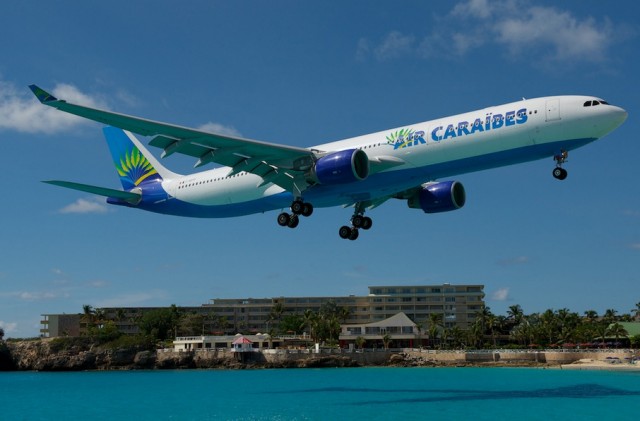
Air Caraibes Airbus A330 over the bay, about to land – Photo: Bernie Leighton | AirlineReporter
My fiancee and I, chatting earlier this year while I was at my computer:
“Hey sweetie, did you realize our honeymoon cruise stops for a day at St. Martin?”
“Um, I think so, yea…”
“Did you know that is where they have the beach with the planes that just about land on your head?”
“Like the videos and pictures you showed me? Wow! That’s awesome! Sounds like we should spend that day there at that beach, you think?”
“Oh man, I am SO marrying the right woman!”
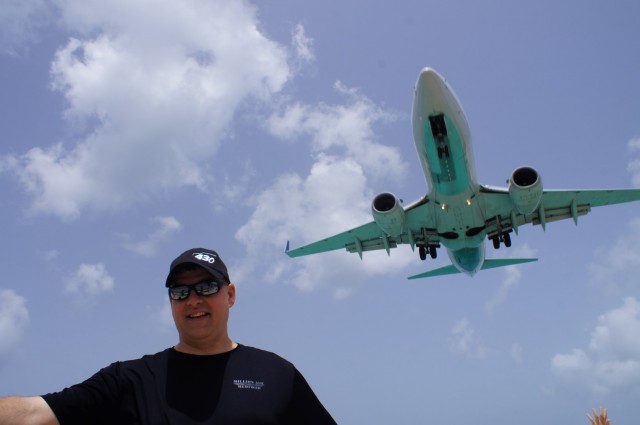
The author standing directly below a Boeing 737 about to land – Photo: Julian Cordle
When I tell people I’m into aviation, my (now) wife likes to describe me to others as “like the super-excited train guy, but with planes”. Tongue-in-cheek, of course. In any case, once we made plans to visit world-famous Maho Beach on St. Martin, she listened to me tell her many times “I can’t believe I get to actually BE THERE” while I was browsing the many stunning photos online.
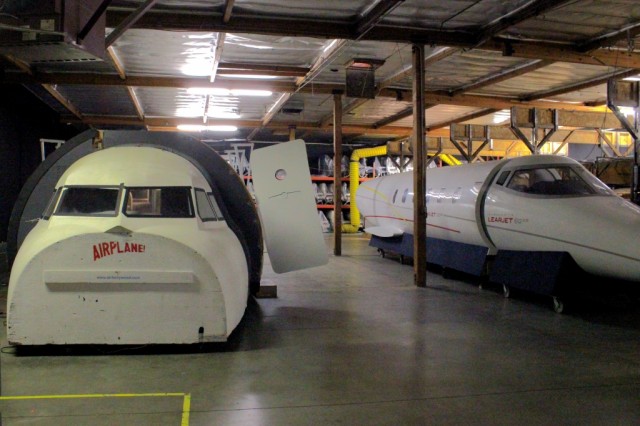
At the front of the first narrowbody set is the flight deck from the movie “Airplane!” – Photo: Ben Granucci | NYCAviation
Story written by Ben Granucci and appears on NYCAviation.com
In 1998, Talaat Captan was a writer and movie producer shooting scenes in an airport for the movie Ground Control, starring Kiefer Sutherland. After experiencing great difficulty coordinating the logistics involved with filming in an active airport, Mr. Captan knew that there had to be a better way. A self described aviation enthusiast himself, he founded Air Hollywood shortly after filming wrapped. The goal of Air Hollywood is to have a studio where all types of aviation scenes can be produced in a film-friendly environment. We recently visited the Air Hollywood studios and got to see all that they had to offer.
Right this way, please!
Right this way, please!
We started with a tour of their collection of full aircraft sets. Air Hollywood has several complete aircraft interiors that can be quickly and easily reconfigured to not only provide a wide variety of interior looks, but also permit filming from any angle necessary. Instead of replicating particular types of aircraft exactly, they have three more generic interiors. As we entered the building, we stepped into a scenery piece that was built to look like a jet bridge. Just like you would board an airliner, we walked down the ramp and turned a corner to see what looked to be the entrance door of a aircraft.
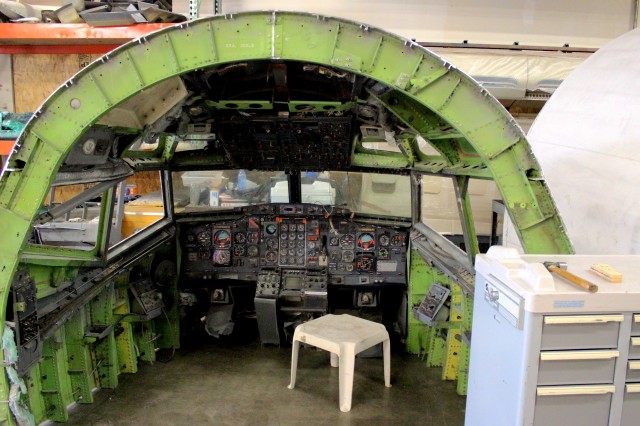
Once upon a time, this was the business end of a 727. Today it is being rebuilt into a fully functional movie set complete with switches that click and lights that glow – Photo: Ben Granucci | NYCAviation.com
However this was not an aircraft at all, but rather the studio’s widebody set. With a shell made of wood and an interior made of aircraft cabin panels, this piece of scenery was somewhere between a Boeing 767 and an Airbus A330 in width. In the condition that we toured it, it was equipped with a small business class cabin and a slightly larger economy class cabin.
All components of the cabin can be removed and replaced in a matter of minutes versus the several hours that a real aircraft would require. The entire aircraft interior, including the seats, were all purchased used. Mr. Captan explained to us that new components are cost prohibitive. For example, one first class seat alone can cost upwards of $30,000 when purchased as new, while the used cost is a fraction of that.
Continue reading Behind the Scenes of Airliners in Movies – Air Hollywood on NYCAviation.com
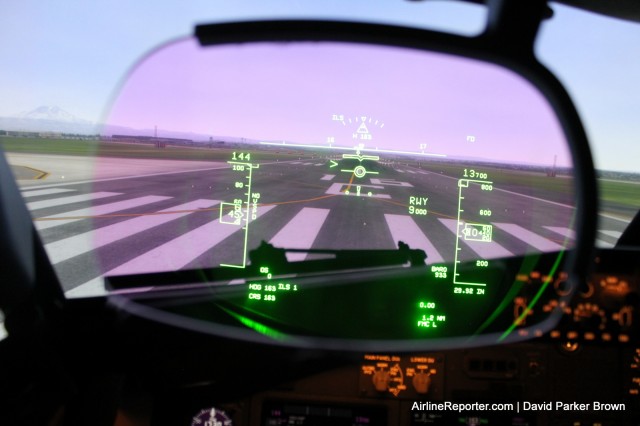
The HUD on Alaska Airlines’ newest flight simulator. Notice Mount Rainier off in the distance on the left.
When Alaska Airlines recently reached out to me, asking if I would like some time in their brand-spanking-new Boeing 737-800 flight simulator, I didn’t know if I should reply with just “yes,” or “hell yes.” (I actually think I went for the latter).
The simulator was so new that it hasn’t been added to Alaska’s training schedule (that will start next week). That was a huge benefit, because it allowed me to experience the simulator for over an hour. I have had the opportunity to be in six other simulators, but typically they are in high demand, so the max time in one is about 15-20 minutes. I was excited to give this one a full-on ride.
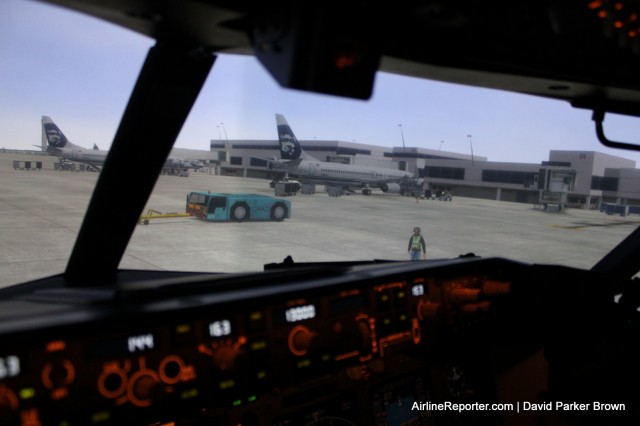
Taxiing at Seattle Tacoma International Airport. The attention to detail was amazing.
Captain Burton, our instructor Dave, PR guru Halley and I had a great time (I felt special that I was given the Captain’s seat). We flew by downtown Seattle, made a difficult approach into Juneau, completed a foggy aborted landing, and more. The only thing Captain Burton wouldn’t let us do is a barrel roll — that’s okay, but I had to ask.
To learn more and follow along with my simulator adventure, check out the full story (with more photos and video) on Alaska Airlines’ new blog. When you are done there, you can also check out more photos of the simulator and Alaska’s flight operations center on our Flickr.
Continue Reading Flying High at Ground Level – Checking out Alaska’s New Flight Simulator
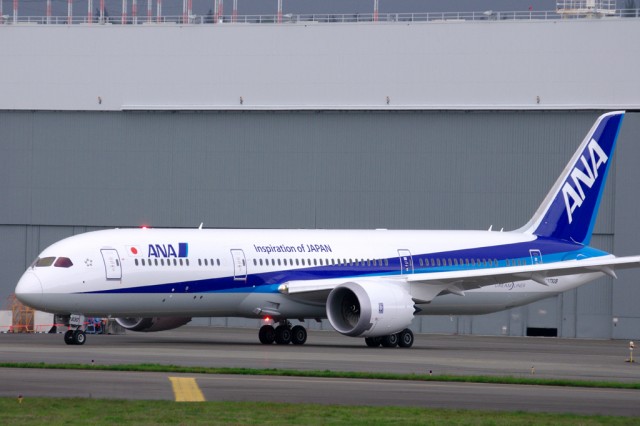
The first Boeing 787-9 for All Nippon Airways (ANA), seen at Boeing Field while conducting tests for Boeing Photo: Mal Muir | AirlineReporter
Several weeks ago, Air New Zealand became the first airline to take delivery of the new Boeing 787-9 — the stretched Dreamliner. With much pomp & circumstance, they took ownership of their “All Blacks” livery aircraft and flew it away back to New Zealand.
Then, just before the end of July, the second 787-9 was delivered to All Nippon Airways (ANA) (JA830A), and it quietly slipped away into the night off to Japan. At the time, it was unknown who might commence 787-9 flights first.
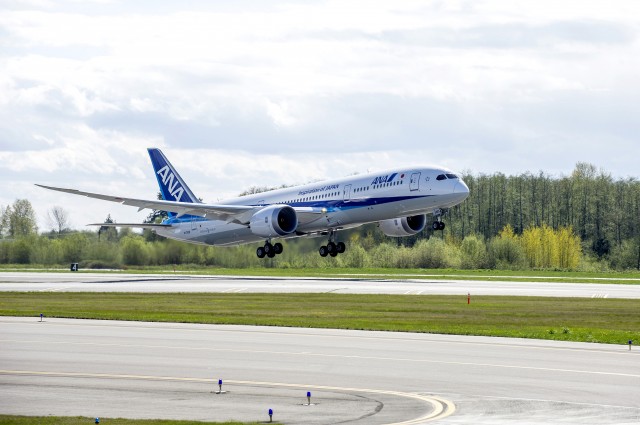
ANA’s first 787-9 departing Everett on delivery to Japan – Photo: Boeing
Air New Zealand, being the first to take delivery, did not plan to start their 787 on a new route until October when they would begin service from Auckland to Perth. The Kiwis had decided to operate flights back and forth between New Zealand & Australia to get their crew used to the aircraft (as this is their first 787) and although they were operating flights with crew onboard, there were a few with just friends and family. Despite that, it was ANA who would challenge the spot as first to operate the newest 787 model.
ANA was the first airline to take delivery of the 787-8, and they originally put it to work on domestic flights within Japan. The airline is also now the largest operator of the 787, with a total of 30 in service; 29 of those are the smaller 787-8, which is split between a long-haul configuration and a higher density domestic configuration.
The newest arrival to the fleet is set up in a domestic configuration as well, with a whopping 395 seats onboard. Meant to replace high-capacity 767s in Japan, the new aircraft will run back and forth between the Tokyo Haneda hub and other major Japanese cities like Osaka and Fukuoka. But could ANA get a 787-9 into service before Air New Zealand? You bet!
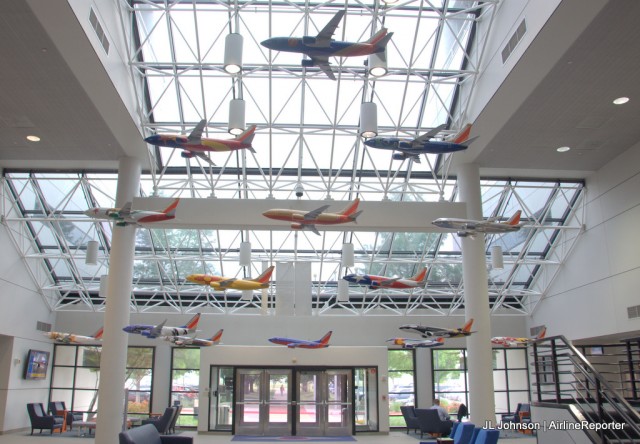
Large models illustrating Southwest’s special liveries hang in the atrium of the company’s HQ
For years I have connected at Dallas Love Field and peered across the aircraft operations area, staring at the home of Southwest Airlines, hoping to one day visit LUV HQ. In the effort of transparency, I’ve made little attempt to conceal my preference for the airline, and we’ll discuss why I think that they’re the best in a bit. But here’s a hint: It’s the culture.
I have a hand-full of friends who work for Southwest and follow a bunch of their employees on Instagram who occasionally post photos from the inside. My desire for a visit intensified when I became aware that the company had recently opened a large addition to their Dallas footprint, just across the street from their long-standing centralized DAL-based HQ. The building, affectionately known as TOPS (for Training and Operations Support), drastically expands the company’s capabilities and makes room for employees of the largest domestic airline to spread their wings.
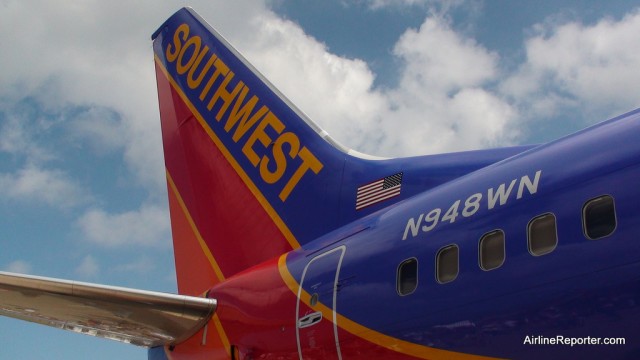
Southwest Airlines tail – Photo: David Parker Brown
After 12 years in corporate America, I have become a self-described boring, stodgy, business-type guy. I think that’s one of the reasons I am so attracted to Southwest’s culture. Because, it’s tough to not have a fun time around people who clearly enjoy their careers and are vested in the mission of their company.
On a recent late-night flight, an attendant came over the intercom to tell us they were turning down the lights and that we were welcome to turn on our overhead lighting. “If you want, push the button with a picture of a light bulb on it.” She continued, “However, pushing the button with the picture of a flight attendant on it will not turn on the flight attendant.”
It was late, we were all tired, and I think it’s fair to say the cabin had let their guard down. This unexpected bit of humor solicited a chuckle from me and a large portion of my 737-trekking peers. It’s these small, unexpected, fun experiences after a long draining day of meetings, charts, and presentations that I have come to rely upon as a part of my decompression ritual.









